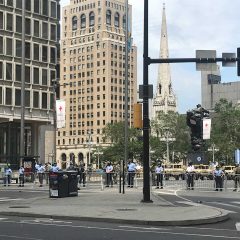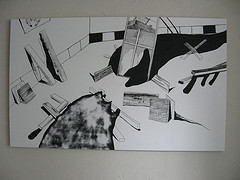
untitled painting by Joe Protheroe
Post-Minimalism and Post-Photoshopism and Post-Illustratorism have all joined forces to abhor the straight line and perspective, abhor the mass produced, abhor the slick perfection and abhor the uniformity that Minimalism and computer graphics–and advertising–promised. Those were the formal issues that struck me silly when I walked into Slought to see The Day After, an exhibit of work by recent MFA graduated of Penn, Tyler and PAFA.
To put it another way, this show is sad and angry, a declaration of innocence lost and dreams tucked away. The Day After is literal in these students’ lives, the day after they have been shot out into the art world from their protected MFA experience; and it’s figurative, the era after 9/11, when the American Dream has collapsed and the American self-image of righteousness, under the Bush administration, has been swept away by the Cheney-Bush-Addington axis of evil (see Jane Mayer’s article in the July 3 New Yorker).
There was a lot to like in this exhibit, and a lot to think about. Some of the work I’d already seen at the Penn MFA exhibit at the Icebox–Wil Medearis‘ Alex-Katzian self-portraits, Pernot Hudson’s blurry family portraits of Boehm birds and other pricy porcelain knick-knacks–but most of it was new to me.

exterior view of Corridor, by Amy Walsh
Amy Walsh’s ramshackle jumbles of random cartons offer peepholes into evocative, familiar spaces–factory loft and city lights, corridor with doors and a window to a blue sky, a building that is either being gutted and rebuilt or has been abandoned before completion, a staircase, a curtain over a doorway. I had thoughts of Urs Fischer and Ilya and Emilia Kabakov. Miraculously, the miniature spaces still bristled with ambition and boldness. I loved this work.

one of the peephole views into The Visitor, by Amy Walsh
What I saw plus what Roberta said about boxes (post here) brought me to the thought that sculpture had changed focus from beautiful exteriors to vulnerable interiors. The exteriors shout, “Can you get past my warts and see me for who I really am?” Walsh is a PAFA grad. (Here are links to my and Roberta’s Flickr sets).
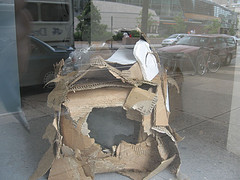
an untitled piece by Blaine Siegel in the window of Slought Foundation
A bristly exterior also covers PAFA grad Blaine Siegel’s sculpture in the front window of Slought, a video screen peeking out from a shingled cave of torn styrofoam and corrugated cardboard. The rough materials and caveman quality reminded me of Thomas Hirschhorn. Siegel’s Gobdiddlymuck monster also dares you to love (Roberta described and photographed Siegel’s Gobdiddlymuck monster so nicely that I’ll just refer you again to her post).
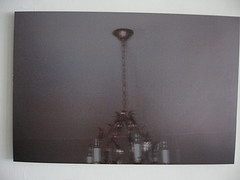
Untowards (09) by Anna Neighbor
Tyler grad Anna Neighbor’s blurry, penumbral “Untoward” photographs–of the part of a chandelier above the lights and a picture of loneliness personified in a double bed with one empty pillow–also dare to show the unlovely and the unloved. Also from Tyler, Joe Protheroe’s deliberately unperspectival, cartoony-crude paintings seem like rebellions against Photoshop, and from PAFA, Max Maddox’s abstractions of crusty gestures dare you to admire their unloveliness. Maddox’s marks made me think of Anne Seidman’s early, Zen gesture paintings–utterly different and yet also challenging and bristly.

a shot from The Baby, by Tricia Lopez
Tricia Lopez’s DVD “The Baby” also demands love for the unlovely, but she puts the beauty on the outside and the ugliness within. A beautiful woman, with a voice distorted to sound deep and disturbed, begs another beautiful woman to accept and love her hurt, broken inner baby. I wondered if this video was influenced by the identity theft commercials, in which an innocent victim channels the voice of the thief.
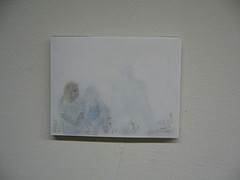
An Appearance of Comprehension, by Michelle Le Claire
Even Hudson, whose paintings of fine family tschotschkes retain some of the attractiveness of the originals, is putting his family jewels on the line, questioning the values they represent and in a way challenging this part of himself that he isn’t so sure he likes. The tiny photo-shaped drawings of childhood innocence lost by PAFA’s Michelle LeClaire also feed into the American Dream and the ugliness beneath the false romanticism of our past.
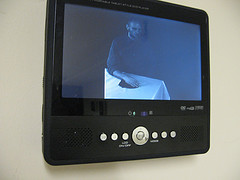
A Slow, Still, Dying, by Brent Wahl
I thought at first that Penn grad Brent Wahl was marching to a different drummer. His DVD A Slow, Still, Dying of an immobile man bleeding out in front of your eyes though, again raises the issue of what’s on the inside, what’s on the outside, and just how vulnerable a human being is. This one is right on the edge of 9/11 thinking, the man looking so tough and soldier-like with his shaven head, stoically sitting as the blood seeps out.
The two outliers were Medearis and Tyler grad Timothy Belknap.
I’m not so sure about Medearis, who puts himself and his girl in a Ralph Lauren social drama. I can’t tell if he loves Alex Katz and Ralph Lauren and these are sincere fantasies, or if the clay-colored skin serves as warning that the fantasy is false and the social aspirations may not be so attractive.
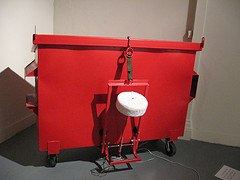
front view of Red Dumpster With Strap-On, by Timothy Belknap
Marching to a different drummer is Belknap. He has gussied up his high-gloss Red Dumpster With Strap-On in a way that emphasizes its perfection as an industrially manufactured product, as a machine (the works are beautifully put together and visible on the inside) and as a toy. He uses its interactive, pristine white-plush drumstick to draw attention. I stepped on the little treadle, waited a little, and sure enough the drumstick pounded the dumpster. Even though I wondered about the sexual implications of a Strap-On, I couldn’t help but think that for Belknap, innocence and optimism were not yet lost.
On the other hand, the dumpster also brought Gunter Grass’s The Tin Drum to my mind, its stealth subject matter of false innocence and moral blindness suddenly flipping my view on the dumpster. This might not have crossed my mind in some other context–and with another group of curators who wear their intellectual and political hearts on their sleeves. Osvaldo Romberg, Aaron Levy and Jean-Michel Rabaté’s choices, when I got done coalesced, into a political vision that transcended the personal stories each of these students had to tell.



